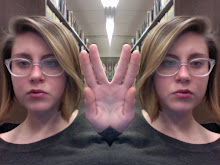Music videos are pure sensation, dependent upon lightning-fast cutting, monumental close-ups, and, above all, synergy between movement and rhythm. Watching them is purest form of visual pleasure, communicated within seconds.
My obsession with music videos was reignited when I spent a disgusting amount of time the past summer absorbing every minute detail of Lady Gaga's videos. Watching "Poker Face," the mindless song and dance routine of pop music videos fell into place in my mind for the first time since fifth grade. Like an action movie, the text of the video isn't as important in and of itself; rather, what is important are the ways in which the text invites spectacle. It's the fantasy of the video, this one moment whereby the song becomes solidified into a series of icon-making images that counts.
I'm biased towards videos that are flashy and overwhelming; I typically hate overly slow or introspective videos. Music videos capture something irreducible about the activity of listening to music. When they're overly cerebral, they're no fun anymore. This is not to say that music videos have to be devoid of intelligent commentary; consider Missy Elliott's subversive toying with gender and race identity in "Work It" (or any of her videos, for that matter).
At the heart of the music video experience is the knowledge that these media objects are part commercial product and part artistry. In the seventies and eighties, music videos were called promotional videos, highlighting a music group's sellable hits. The Beatles pioneered a parallel development in music video innovation, and through their various films were among the first artists to use the combination of audio and visual sensation to produce an enhanced music experience. By the mid-nineties, MTV zeroed in on the inherent artistry involved in producing these videos, and the collection of rising visual artists that helmed them, and started to list the video's director along with the song title and the record company.
But let's return to fifth grade. In 1999, TRL was one year old and at the height of its popularity, with nearly 800,000 viewers. Carson Daly paraded the machinery of the commodity culture industry through my TV room every afternoon: not only snippets of music videos (compiled by a complicated equation of viewer votes, Neilson Soundscan, and, in later years, internet downloads), but also television shows, movies, and a slew of other tie-in products that promised to bring us closer to our favorite celebrities. TRL compressed two existing video shows, "Total Request" and "MTV Live," into an impressively calculated to push to buffer the dwindling number of music programs as the network began to expand its collection of reality programming, introducing shows such as "The Osbournes."
Growing up on MTV in this moment, the beginning of the end, so to speak, meant encountering branding and image making at its highest pitch. In a sense, TRL was a show that fed off of other shows that brought the viewer face to face with the (albeit stylized) inner workings of the final commodity product. Maybe you didn’t see the entire music video on TRL, but you certainly could learn about the pyrotechnics and gadgetry that propelled these videos in “Making the Video.” (Below is the best episode: Britney Spears' epic "Toxic"). For every thirty-second sound byte interview on TRL, MTV was guaranteed to focus an episode of “Diary” on one of those artists.
To argue that MTV was, and still is, an entirely commercial product is a moot point. What I remember from watching MTV ten years ago is watching these intricately orchestrated moments unfold across several different shows. The process, not the final product, was the channel’s focus in these years. Viewing this process, no matter how mediated, added something not too far from depth to bubblegum pop acts. I believe that it is during these moments that the music video became more than the sum of it’s bastardized commercial parts, and was acknowledged as an entertainment product in its own right, rather than simple tie-in product.




No comments:
Post a Comment